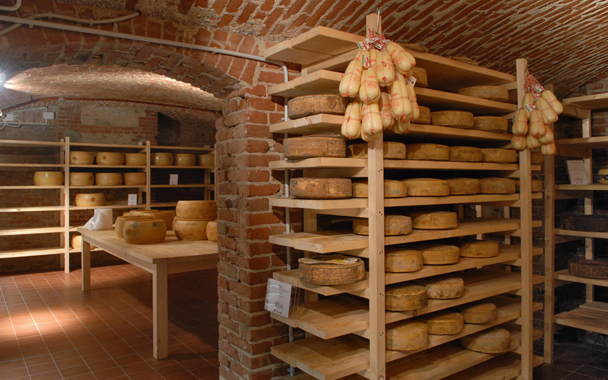The punning name can be forgiven: Eataly, on the outskirts of Turin in Italy’s Piedmont region, might just be the world’s most engaging and (successfully) ambitious food store—though “food store” only tells part of the story. Occupying almost 120,000 square feet of former factory space in the industrial suburb of Lingotto (the site was once the Carpano vermouth plant) Eataly is a multi-part market, restaurant complex, and educational facility complete with library and classrooms. Imagine a combination of the Central Market in Austin, the Harrod’s food halls in London, and New York City’s Zabar’s, with a touch of the Slow Food University thrown in. All skylit brick and tile, Eataly is a warren of mini-shops and “ristorantini” devoted to the best foods and drinks of—in this order—Piedmont, Italy as a whole, and other selected corners of Europe.
The produce market that runs down the center of the main floor is a mild disappointment—the fruits and vegetables sold are of good quality (at least based on the green tomatoes and blood oranges I bought), but the selection is reasonably generic, and much of it has the look of supermarket uniformity. Still, the treasure troves on both sides and on the lower level are downright exciting. It’s hard to know which way to turn. Roughly 150 kinds of cured meats are on offer (including superb Spanish hams, though these seem somewhat superfluous with the best of Parma and San Daniele right there too), as are 200 or so varieties of cheese (mostly Italian, including Parmigiano-Reggiano of various “vintages,” with a few French cheeses thrown in); more than a dozen types of artisanal bread from a wood-burning oven; about the biggest and best array of (mostly Italian) olive oils I’ve ever seen; scores of pastas, both dried and fresh; coffees (including the Hue Hue brand, sourced from small farms in Guatemala and roasted by inmates at Turin’s Vallette prison); a miscellany of artisanal foods selected by Slow Food; more than 200 beers; hundreds of wines…
And if you’re just passing through and can’t buy anything to take home, don’t worry: There’s a Michelin one-star restaurant downstairs (with the unwieldy name of Casa Vicina GuidoPerEataly), but even better are the ristorantini, mini-restaurants in lunch-counter format, which serve copious quantities of the best market food at affordable prices: fish (both raw and grilled), smoked speck and South Tyrolean sausages, a daily selection of pastas and pizzas, and more. I couldn’t resist the salumeria, where I tried eight or ten meats I can’t buy in the U.S., like the super-prosciutto called culatello, cooked Parma salami, and spalla cruda, a ham-like meat made from pork shoulder.
There are smaller shops operating under the Eataly name in Milan and Bologna, with more planned around Italy, and there’s a version in Tokyo. Next up: New York City, where restaurateur Joe Bastianich plans to open an Eataly next year.
Eataly Via Nizza 230/14 (in front of “8 Gallery”), Turin Lingotto (39-011-19-50-68-01; eatalytorino.it)



 Pinterest
Pinterest


